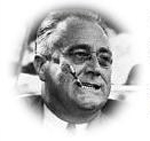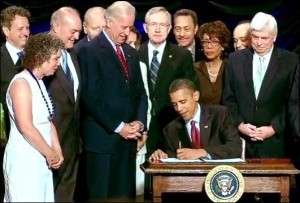By Pam Martens and Russ Martens: March 15, 2017
Following the Wall Street crash of 1929, thousands of banks failed in the United States. More than 3,000 banks went under in 1931 followed by more than 1400 the following year. There was no Federal insurance on bank deposits in those days so both depositors and shareholders were wiped out or received pennies on the dollar when the banks went bust. This deepened the panic and deepened the Great Depression.
Many of the bank failures stemmed from the banks using depositors’ money to speculate in the stock market, sometimes to manipulate the price of their own stock.
Franklin Delano Roosevelt was sworn in as President of the United States on March 4, 1933. Two days later he declared a national banking holiday, meaning that he closed all the banks and sent in the examiners to determine which ones were sound and which ones were insolvent. The banking holiday lasted to March 13. Just three months later, on June 16, 1933, FDR and Congress enacted the Glass-Steagall Act also known as the Banking Act of 1933.
The Glass-Steagall Act created Federal deposit insurance at commercial banks while simultaneously restricting their ability to act as Wall Street casinos and speculate in stocks or risky debt securities. The legislation required that commercial banks had to be separate from investment banks and brokerage firms.
That legislation protected America’s banking system from the hubris of Wall Street traders for the next 66 years until its repeal on November 12, 1999 during the Clinton administration.
It took just 9 years after the lifting of the Glass-Steagall Act for Wall Street to once again crash in epic fashion. But this time, instead of having thousands of insolvent small and medium size banks going belly up around the country, we had behemoth banks like Citigroup, Wachovia, Washington Mutual, Lehman Brothers and Merrill Lynch either going belly up or being propped up through secret funding from the Federal Reserve.
Because banks had been allowed to grow into behemoth financial institutions, owning insurance companies, investment banks, brokerage firms, commodity trading operations, and on the hook for trillions of dollars in derivatives, while simultaneously holding Federally insured deposits backstopped by the U.S. taxpayer, Congress was forced to bail out Wall Street by bailing out its biggest banks to avoid a run on all of the banks.
But precisely because Congress had this bailout gun put to its head by Wall Street, because Congress could see firsthand the economic devastation that the lack of separation of banking and Wall Street speculation had inflicted on the nation, the only rational response should have been for Congress and President Obama to take quick, decisive action to make sure this could never happen again and pass legislation restoring the Glass-Steagall Act.
It took FDR just three months in office to pass meaningful and effective banking reform legislation that would serve the nation’s interests for the next seven decades. What President Obama did, on the other hand, speaks volumes as to why he is so focused and adamant about controlling the narrative of his presidency.
President Obama was sworn in on January 20, 2009 in the very midst of the Wall Street crash. In the prior six months Fannie Mae and Freddie Mac had been taken over by the Federal government and placed in conservatorship (where they remain today); Lehman Brothers, which owned two FDIC-insured banks, had failed and was in bankruptcy; the investment bank and brokerage firm, Merrill Lynch, which owned three FDIC insured banks, was teetering and merged with Bank of America; Citigroup, parent of the massive Citibank insured depository, had lost more than 80 percent of its stock market value and received the largest taxpayer bailout in U.S. history; AIG, the giant global insurance company, had taken the other side of bad derivative bets from Wall Street banks and failed. AIG received more than $180 billion in taxpayer bailout guarantees from the Federal government and half of that money went out the back door to the Wall Street firms to cover their derivative bets. Even AIG had been allowed to own an insured depository bank.
And on and on went the saga of hubris and greed and reckless gambles with depositors’ money that could be traced directly to the repeal of the Glass-Steagall Act.
At the time of Obama’s inauguration in January 2009, the Democrats were in control of all three branches of government. Obama had two years to pass meaningful Wall Street reform. Instead, he signed into law the toothless Dodd-Frank financial reform legislation in 2010. Today, little has changed in the structure that caused the 2008 collapse, the greatest financial crash since the Great Depression. In important ways, the structure has grown exponentially worse.
Two of the biggest investment banks on Wall Street, JPMorgan Chase and Citigroup, own two of the largest insured commercial banks in the country. Bank of America, one of the largest insured commercial banks in the country, owns Merrill Lynch, one of the largest investment banks and brokerage firms in the country. JPMorgan Chase, Citigroup and Bank of America hold trillions of dollars of risky derivatives on the books of their FDIC-insured banks – making it inevitable that they will be able to put a gun to the head of the U.S. taxpayer if they need a future bailout.
After three criminal felony counts against JPMorgan Chase and one criminal felony count against Citigroup and billions of dollars in settlements for both banks related to charges of mortgage and securities fraud, the same men have kept their seats as Chairman and CEO at these banks. Obama’s Justice Department did not demand that these men resign in order to settle the charges, despite the fact that both banks are horrific recidivists.
The system that allowed these banks to directly pay rating agencies like Moody’s and Standard and Poor’s to assign triple-AAA ratings to toxic securities is still in place. Wall Street banks continue to pay to get ratings assigned.
Dodd-Frank’s promise to “push out” derivatives from the FDIC-insured commercial banks fell by the wayside when Citigroup used its muscle to gut the measure by having an amendment tacked on to the must-pass spending bill in December 2014.
To put it as bluntly and charitably as we can, Obama was no FDR when it came to Wall Street reform. The nation’s financial system remains dangerously at risk as a result.
Related Article:



